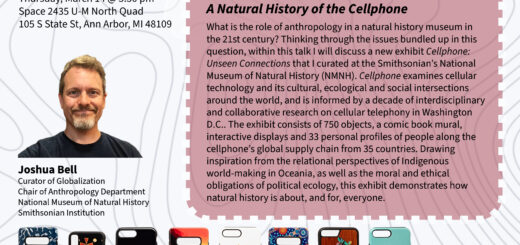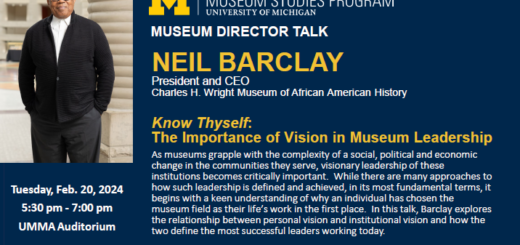Museum studies teaching has a deep history at the University of Michigan, spanning nearly ninety years and divided into three distinct phases. The first, beginning in 1931, resulted in the Museum Science Department, based in the then new University Museums Building (later renamed the Ruthven Museums Building). The work of that department was closely tied to the University’s natural history collections and exhibitions. The second phase, from 1959 to c. 1990, the Museum Practice Program, was art-focused and located in the Museum of Art. And the third, and current phase, launched in 2001 is the interdisciplinary, critical-practice focused, Museum Studies Program, part of the Rackham Graduate School.
The Museum Science Department
In the fall semester of 1931, University President and Director of the University Museums Alexander Ruthven joined with Crystal Thompson, Director of Visual Education in the University Museums, to offer the first documented U-M course in museum studies. Ruthven was a zoologist and his role as Director of the University Museums included responsibility for the Museums of Zoology, Anthropology, Paleontology, Classical Archaeology, and the University Herbarium. Listed as Zoology 173, this graduate-level course was titled Museum Methods. A follow-up course, Zoology 174, Advanced Museum Methods, was taught in the winter semester by Thompson and a curator from the Museum of Zoology (either Helen or Frederick Gaige; only the surname is listed in surviving records). The sequence was offered again in the 1934-1935 academic year.
Ruthven stepped down from his role as Director of the University Museums (also referred to as the Museums Division) in 1936 to devote himself full-time to the job of University President. He was succeeded as Museums Director by Carl E. Guthe, who was also Director of the Museum of Anthropology. Guthe had a more ambitious vision for museum studies training. In 1938, the Graduate School approved his request to offer a six-course curriculum under a Department of Museum Science. These courses, which were offered in the 1938-1939 academic year, were:
- Museum Science 152: Museum Theory
- Museum Science 161: Collections
- Museum Science 170: Visual Education in Museums
- Museum Science 185: Preparation of Technical Papers
- Museum Science 205 and 206: Special Problems in Museum Science.
The following year, several new courses were added to this list, with the first two designed to provide internship experiences:
- Museum Science 109 and 110: Anthropological Museum Techniques
- Museum Science 112: Herbarium Methods
- Museum Science 159: Collections and Techniques
- Museum Science 173: Museum Techniques.
These courses were offered by various curators in the four research museums in the Ruthven Building (Anthropology, Paleontology, Zoology, Herbarium) and by staff in the Visual Education Department that served the four museums. Museum staff were granted temporary faculty appointments to teach them. The Department of Museum Science was not a degree-granting program; however, records indicate that some students did request special Masters Degrees in Museum Science.
Museum Science courses were offered regularly from 1938 to 1945. Guthe left the University in 1944 to become director of the New York State Museum. While several courses in Museum Science continued to be offered, it appears that interest in the program declined significantly after Guthe’s departure. Indeed, in 1955, Irving Reimann, Director of the Exhibits Department (formerly Visual Education) wrote to the Museums Operating Committee (which had replaced Guthe in having oversight for the museums), and observed that there was insufficient interest in museums classes, and only the special topics courses should be retained. Today, the only remaining remnant of what had been a robust museum science program is MUSMETHODS 499, offered periodically by the Museum of Natural History.
The Museum Practice Program
The second phase of museum studies teaching at the University began in the late 1950s when Charles Sawyer, then the Director of the U-M Museum of Art, laid the foundations for what was to become the Museum Practice Program (MPP). This was an entirely separate initiative from the earlier Museum Science Department, which appears to have been entirely forgotten. Through its more than thirty-year history, the Museum Practice Program was situated in the Museum of Art, with the Director serving as its Chair. Primarily oriented toward graduate students with interests in art history, in its heyday the MPP also attracted students from history, classical archaeology, American studies, and anthropology.
The MPP passed through a number of iterations. It began as a series of seminars and later offered a Master of Museum Practice, an MA in the History of Art with Museum Orientation, and finally, starting in 1978, a Graduate Certificate in Museum Practice under the Rackham Graduate School. It is difficult to quantify exactly how many students graduated from the Museum Practice Program in its various forms; however, a conservative estimate is well over one hundred. We do know that many graduates went on to careers in museums; several became leading figures in the museum profession.
In the late 1980s, several factors led to a decline in enrollment in the MPP. In the early 1990s, the program ceased accepting students. The second phase of museum studies teaching drew to an end.
The Museum Studies Program
In 1998, the newly appointed Director of the U-M Museum of Art, James Steward, was charged with conducting a feasibility study to determine whether the MPP should be resuscitated and, if so, what configuration it should take. Interest was strong across the University and two years later, a report was submitted to the Provost recommending that a new Museum Studies Program (MSP) be created. Unlike its two predecessors, this new program would not focus on particular kinds of museums but instead would be expansive to reflect both the University’s interdisciplinary orientation and the intellectual changes that had reshaped museum theory and practice in the late twentieth century. The program was to be housed in the Graduate School rather than any department or college to affirm the interdisciplinary scope of museum work and museum theory.
In 2001, the University launched a national search for a Director of the program, hiring Raymond Silverman, a recognized leader in museum studies and specialist in African art history. Silverman joined the University in 2002 and initiated a year-long university-wide discussion as he crafted the program’s curriculum and introduced MSP to the larger university community. In 2002, Dr. Bradley Taylor, a graduate of the earlier MPP, joined MSP as Associate Director. Together, they crafted a vision for a program that integrated theory with practice and would engage students and faculty from across the University as well as museum professionals from throughout the region.
The program currently offers a graduate certificate to students interested in complementing their discipline-based work in masters or doctoral programs across the University. The program is also open to emerging museum professionals and others who wish to pursue it as a free-standing degree. The MSP accepted its first cohort of students in fall 2003, and to date has enrolled more than 125 students from 30-plus graduate programs and nine colleges. Like earlier graduates of the Museum Practice Program, many of our MSP graduates have continued on to careers in museums and academic departments.
Under Silverman’s leadership, MSP developed a robust schedule of public programming—including annual lecture series, symposiums, workshops, and conferences. Beginning in 2007, MSP began its Visiting Scholar Program, which hosts a distinguished museum leader on campus for a week each spring. In 2010, the program launched its online Working Papers in Museum Studies series to highlight student and scholarly research. Silverman and Taylor also formed strong relations with more than 40 regional museums (now up to nearly 60), on the U-M campus and across Michigan and northern Ohio. Student learning is greatly strengthened by these relationships—through site visits, capstone projects and guest lectures from their directors and staff.
In 2009, the MSP established an undergraduate minor in museum studies offered through the College of Literature, Science and the Arts. This minor shares the broad interdisciplinary vision of the graduate certificate and has attracted students from across the university. In the summer of 2012, responsibility for the administration of the minor was transferred to the Department of History of Art; both undergraduate and graduate programs remain closely linked and continue to share a common vision and commitment to the interdisciplinary potential and contributions of museums.
After leading the program for ten years, Raymond Silver stepped down from the position of director in 2012. The accomplishments of the program over its first decade were celebrated in the conference and gathering called MSP@10.
Carla Sinopoli, anthropologist and Curator of Asian collections in the Museum of Anthropology succeeded Silverman as Director in September 2012. In 2018, Margaret Hedstrom, professor from the School of Information, began to serve as interim Director. In Fall 2020, Kerstin Barndt, Associate Professor in German Languages and Literatures, began her role as MSP’s Director. Under her leadership, MSP has continued to build on its impressive record of success and has begun several new initiatives.
Remembering Charles Sawyer
Charles Sawyer generously accepted an invitation to offer his Reflections on the U-M Museum Practice Program, 1959-1980.
Charles Sawyer sadly passed away on February 25, 2005, at the age of 98. Former Museum Studies Program Director, Raymond Silverman, and Museum Practice Program alumna, Marjorie Harth, offer tributes to the memory of Charles Sawyer.


